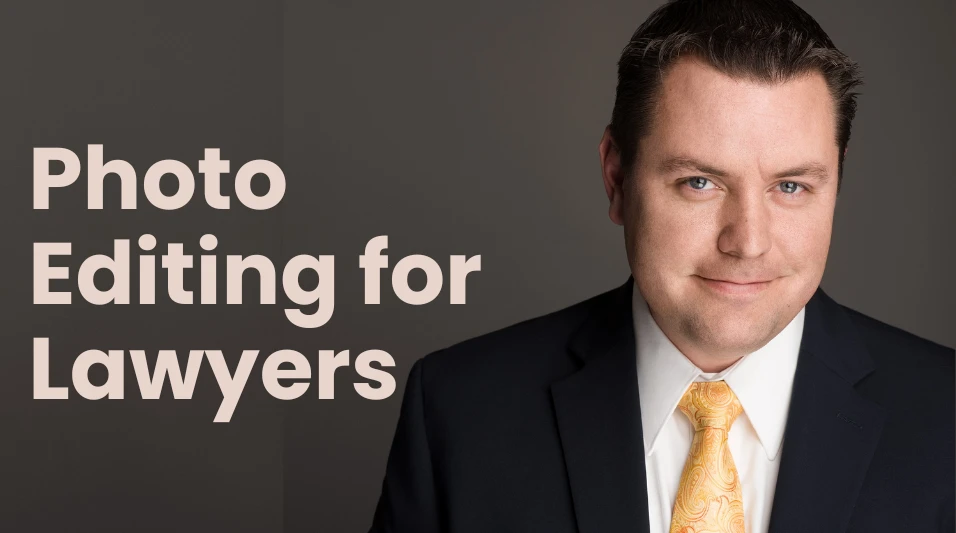As a lawyer, your professional headshot is more than just a photograph; it’s a representation of your personal brand and the first impression clients, colleagues, and even the courtroom have of you. But how do you make sure your headshot reflects your professionalism, credibility, and approachability, all at once?
In this guide, we’ll break down the essentials of photo editing for lawyer headshots and how to ensure they align with your branding goals. We’ll walk through editing techniques, branding strategies, and tips for creating a polished, professional image that stands out.
Quick Takeaways
- Clean and professional headshots: Neutral background, formal attire, and approachable expression.
- Basic photo editing: Correct lighting, retouch imperfections, and ensure natural tones.
- Consistency: Use the same headshot across your website, LinkedIn, and business cards for brand consistency.
Why Your Professional Headshot Matters
Your headshot isn’t just another photo; it’s a key element of your personal branding. For lawyers, a strong headshot communicates trust, professionalism, and competence. Whether it’s for your website, LinkedIn profile, or speaking engagements, your headshot helps shape first impressions.
But lawyers have a unique challenge: you need to balance professionalism with a sense of approachability. Too stiff, and you might seem cold or unapproachable; too relaxed, and you might not project the authority you need.
Learn More: Best Free Photo Editing Tools
What makes a great headshot for lawyers:
- Facial expression: A soft smile or neutral, confident look works best.
- Attire: Stick with classic legal attire—suits, blazers, and ties for men, and professional dresses or suits for women.
- Background: Opt for a simple, neutral background (like white, gray, or light blue) that doesn’t distract from you.
Photo Editing Tips for Lawyer Headshots
Once you have the perfect shot, the next step is editing. But photo editing for a lawyer’s headshot needs to be subtle and professional. Here’s a step-by-step guide to editing your headshot so that it looks polished without being overdone.
1. Correct Lighting and Exposure
The first step is to adjust the lighting. Legal headshots should have a bright, clean feel, but without looking overexposed or harsh. Use photo editing tools like Adobe Lightroom or Capture One to adjust the exposure, shadows, and contrast.
- Increase brightness to bring out details in the face, but keep it balanced.
- Reduce shadows to soften harsh lines, especially around the face.
2. Retouch Blemishes, Not Character
As a lawyer, you want to look professional but not too airbrushed. The key is to remove distracting blemishes while keeping the photo realistic.
- Use tools like Photoshop or Lightroom’s Spot Healing Brush to remove temporary blemishes (e.g., pimples, redness).
- Smooth skin slightly, but avoid over-smoothing, which can make the image look unnatural.
- Remove flyaway hairs or adjust minor distractions, but keep the retouching subtle.
3. Enhance Colors, but Stay Neutral
For lawyer headshots, it’s best to keep colors neutral and professional. You don’t want bright or distracting hues in your image, but some basic color correction can enhance the overall appearance.
- Correct white balance: Ensure that your skin tones look natural. Avoid overly warm or cool tones.
- Neutralize background colors: If the background is slightly tinted, use editing tools to make it more neutral (white, gray, or muted tones).
4. Cropping and Framing
Framing is essential for legal professionals. Your headshot should have enough space around your head and shoulders to project openness, but it shouldn’t be so far out that it loses focus.
- Use the rule of thirds: Your eyes should align with the top third of the image.
- Leave enough space above the head to keep the shot balanced.
Learn More: Questions to Ask Immigration Lawyer
Branding: Creating a Cohesive Look Across All Platforms
Lawyers benefit from consistency across their online presence. Your headshot should be the same across your LinkedIn profile, website, firm bio, and business cards. This creates a cohesive, professional brand that clients can recognize.
Here’s how to achieve branding consistency through your headshot:
- Same Background and Attire: Keep your attire and background consistent across all platforms to reinforce your brand.
- Align with Firm Branding: If your firm has specific brand colors, reflect them subtly in your clothing or background.
- Use the Same Headshot: Don’t use different headshots for different platforms. One consistent headshot boosts recognition.
The Best Tools for Editing Lawyer Headshots
Editing professional headshots doesn’t require a full-blown photography studio. Here are some of the best tools to use:
1. Adobe Lightroom
- Why I recommend it: It’s incredibly user-friendly for professionals who aren’t photographers. You can easily adjust lighting, exposure, and color without the steep learning curve of Photoshop.
- Best use case: Brightening, enhancing skin tones, and applying light filters to improve the overall look.
2. Adobe Photoshop
- Why I recommend it: Photoshop gives you more control over detailed edits, like removing blemishes, retouching, and adjusting backgrounds.
- Best use case: Advanced retouching, cropping, and removing distractions like flyaway hairs.
My Experience with Headshot Editing for Lawyers
I’ve worked on 68 Immigration Lawyers headshots, and the key is always balance: keeping the photo polished but authentic. One time, I edited a headshot for a partner at a mid-sized law firm. The initial photo had harsh shadows and slightly uneven skin tones due to natural lighting during the shoot.
I used Lightroom to adjust the exposure and even out the shadows, then Photoshop to gently retouch minor imperfections. The result was a professional, approachable image that the lawyer used across their digital and print materials.
The Bottom Line
In the legal profession, appearances matter. A well-edited, professional headshot is a key part of your branding strategy. By following these editing tips, you can ensure that your headshot reflects both your professionalism and your personality.




